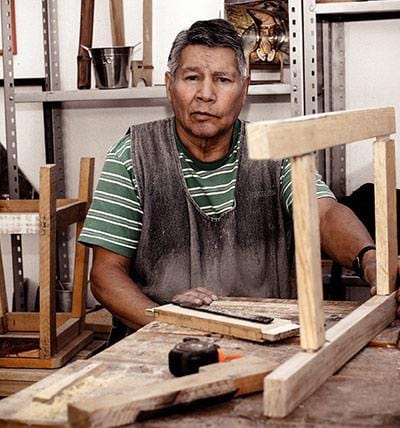If you're new to guitar building, you're probably wondering what type of wood is best for your new instrument.
You have several options: Koa, Brazilian rosewood, Maple, and Cedar. But how do you choose between the various types of wood?
In this article, we'll explain which types are best for guitars and why they're important. Also, find out why Koa is better for guitars than Brazilian rosewood.
Koa Wood for Guitars
One of the reasons why koa wood is so desirable for guitars is because it sounds better with age. New guitars made of Koa tend to sound bright in their first years of life, but over time, koa guitars will tone down and develop a warm and midrange-like sound. As the wood gets older, it becomes more mellow, which results in a broader, more complex tone.
The price of Koa wood is unbeatable. Although it is indigenous to Hawaii, Koa's price is out of reach for most people. Premium koa lumber costs from $60 to $120 per board foot. The price also depends on the figure and the reputation of the exotic wood dealer. Koa is not widely available in the US. The only way to get your hands on a quality guitar made from this exotic wood is to spend a lot of money.

If you're deciding between Sitka spruce and Koa, you'll have to decide which one is best for you. A lot will depend on your taste and preference, but there are some factors that you should consider before making a decision. First of all, make sure you're not using Koa from a conflict zone. If you can't find Koa on the island where you live, there's another alternative.
Cedar Wood for a Guitar
When you buy a guitar, the top might be made of spruce or cedar wood. You may not even be able to tell the difference. The manufacturer's description of the guitar is most likely true. However, no two pieces of wood are exactly the same. Even two guitars made by the same person will have slightly different wood types. Here are some advantages and disadvantages of cedar wood.
Cedar is less dense than spruce, giving it a warmer tone, but it also tends to lose clarity and brightness when played hard. However, some guitarists prefer the warmth and character that cedar produces. Also, cedar guitars are more desirable among classical guitarists than for guitarists who like to strum the guitar hard. They are also quieter than other woods and they will not sustain their sound very long.
Another advantage of cedar is its lightweight. Acoustically, this type of wood is perfect for playing in the middle. However, if you play it in a loud environment, you might not be able to hear the sound clearly. In this case, Spanish cedar may be the better choice. This type of wood has similar properties to cedar but is considerably lighter in weight. These qualities make cedar a more versatile wood for making guitars.
Brazilian Rosewood
Many guitar enthusiasts have heard of the beauty and brilliance of Brazilian rosewood, but few of them own one, let alone play it. A guitar with this type of wood is truly legendary. The story is built on the pre-war guitars owned by some of the world's greatest guitarists.
These guitars have become legendary for their rich tone and durability. However, they are not cheap, so the question of whether Brazilian rosewood is best for guitar making is not an easy one to answer.
When choosing tonewood for a guitar, you should always consider the type of wood. If you're considering Brazilian Rosewood for a guitar, you should consider the type of sound you're looking for. Indian rosewood has a warmer tone than Brazilian, but both kinds of wood have similar appearances. Indian rosewood has a warmer tone than Brazilian rosewood, but it cuts out the midrange and produces a more even sound. Brazilian rosewood guitars are known for their warm, full tone.
A traditional choice for classical guitars, Brazilian rosewood, is a beautiful, prized tonewood. Its density, stiffness, and resonance make it one of nature's finest materials. However, there are species-marginal varieties of this wood that are very drab. If you're interested in purchasing a guitar with a Brazilian rosewood top, make sure to purchase it with a certificate of provenance.
Maple Woods
The sound of a maple guitar is surprisingly clear and focused. This dense wood makes a guitar sound particularly loud and focused and is an excellent choice for live performance. A maple instrument cuts through other competing sounds and helps define each note clearly. Despite its lack of sustain, maple guitars tend to sound clear and focused and have a high response rate and low overtones, meaning that the guitar won't produce much feedback when mic'd up.
If you are concerned about the tone of your instrument, you can consider getting a roasted maple neck. This type of maple is much more resistant to changes in humidity and temperature and is perfect for travel. Generally, you don't need to finish maple necks, but the result will be a guitar that sounds warmer and brighter than a standard maple body. If you are unsure of whether maple is the best choice for your instrument, you can watch a video produced by Warmoth Guitars comparing the sound of various types of maple.
Maple is most commonly used for the body of an electric guitar, though it can also be used for the neck. The light color of maple makes it a particularly attractive choice, and it can also enhance other woods' radiance and brightness.
Despite its relatively low hardness, maple is also not very effective at producing bass tones. If you are not convinced about maple, just try a maple guitar - you will never look back.
Ash
One of the most common woods for guitar bodies is Ash. This wood is popular for its bright tone and warmth, while basswood tends to muffle high notes.
While Ash is usually used in electric guitar bodies, the two varieties are slightly different.
Hard Ash is the most popular type, while soft Ash is more versatile and often comes in a swampy appearance. Ash is one of the best guitar woods for its affordability, Ash was used in the early 1950s by Leo Fender.

It was also a popular choice for other builders in the time before Ash's depletion. Its grain pattern is striking, and it lends itself well to natural and transparent finishes. Ash is not just a good choice for guitars but also makes a great instrument! A lot of rock stars have used ash guitars.
Paulownia: This type of wood is heavier than Alder and is a popular choice for guitars that feature a solid color finish. The grain of this wood is relatively tight, which can dampen high tones and stimulate the weaker end of an instrument.
Basswood: Similar to Alder but with a silvery gray hue, Paulownia is popular for economy models. However, it is prone to dent and scratch.
Spruce
If you're looking for the best tonewood for your acoustic guitar, you've probably heard of spruce. This softwood is typically used for tops on hollowbody designs, and it is surprisingly good for guitar tones. The wood is also lightweight and comparable to common solid-body tonewoods. Its inherent beauty is one of the reasons why spruce is a popular choice for guitar tops.
The top of your spruce guitar must be quarter sawn, but some top makers use slab-cut wood for the sides and back. You can identify this wood by the light and dark portions of the grain line. These represent the spring and summer growth of the tree. Be careful not to see too much difference in the shade of the wood as it represents substantial changes in humidity. A freshly-cut spruce guitar is white but will mature into a rich honey-colored tone as time passes.
While maple is a popular wood for the back and sides of acoustic guitars, spruce is used most often for the top. The spruce wood has excellent resonance and is less prone to feedback. It is also more focused on individual notes, making it a desirable choice for lead guitar players looking for clear note definitions. As light-colored wood, maple can be stained darker to contrast with the spruce top.
Alder
For guitarists who prefer a more balanced sound, Alder may be the best choice. It is an excellent choice for lead and rhythm guitars, with no weak spots in the frequency range. It is fairly inexpensive, though it lacks the strength needed for guitar necks. Fender has been using Alder on its instruments since the 1950s. Here are some of the benefits of this wood. And read on to find out how it can benefit your guitar.
The first thing you should know about Alder is that it is a soft hardwood, so it is easy to scratch. Its grain is not as tight as that of pine or Ash, which means that you can get more straight lines in your guitar body. Unlike pine and basswood, Alder does not require grain filler, making it a much easier material to finish. In addition, Alder requires less finishing than other softer woods.

Hard maple is an excellent guitar wood that can produce a wide range of weights. It has a rich, warm tone that is well-balanced.
Its distinctive grain pattern allows it to hold a high-quality finish and the warm tone it gives makes it the preferred choice for guitars made by the Gibson family.
Hard maple is also an excellent choice for the neck. Although it is less common in guitar bodies, it adds a rich, full tone to the instrument.
Conclusion
There are a few different types of wood that are commonly used to make guitars, and each has its own unique sound and feel. The most common woods used in guitar construction are maple and rosewood. Maple is a hardwood that is typically used for the body of electric guitars. It has a bright, clean tone and is very versatile. Rosewood is typically used for the fretboards of electric guitars. It has a smooth, even texture and a dark, rich sound.
People Also Ask
What type of wood is best for an acoustic guitar?
There are a few different types of wood that are commonly used to make guitars, and each has its own unique sound and feel. Maple is a hardwood that is typically used for the body of electric guitars. It has a bright, clean tone and is very versatile. Mahogany is a softer wood that is often used for the necks of electric guitars. It has a warm, rich sound and is very durable. Rosewood is typically used for the fretboards of electric guitars. It has a smooth, even texture and a dark, rich sound.
What is the best wood for a solid body guitar?
There are many different types of wood that can be used for a solid body guitar, but some are better than others. The best woods for a solid body guitar are those that are strong and durable yet still lightweight. The most common woods used for solid-body guitars are alder, ash, basswood, and maple. Each of these woods has its own unique properties that make it ideal for a solid-body guitar. Alder is a lightweight wood that is very strong and has a good tonal quality. Ash is a bit heavier than Alder and is also very strong. It has a bit more of a "snap" to its sound and is often used for heavier styles of music. Basswood is a lightweight wood that is soft and easy to work with. It has a very warm sound and is often used for jazz or blues styles of music. Maple is a hardwood that is very strong and has a bright, clean sound. It is often used for rock or metal styles of music.
What type of wood is used in guitars?
There are a variety of woods that can be used in guitars, each with its own unique characteristics. The most common woods used in guitars are mahogany, maple, and rosewood. Mahogany is a very strong and durable wood that gives a warm, rich sound to the guitar. Maple is a harder wood that gives a brighter sound to the guitar. Rosewood is a softer wood that gives a darker sound to the guitar.
ABOUT THE AUTHOR
Nurlana Alasgarli
Content Specialist
Nurlana Alasgarli is a professional copywriter with more than 6 years of creative writing experience. Having lived and experienced all over the world, there are many writing genres that Nurlana follows, including nature, arts and crafts and the outdoors. Nurlana brings life to content creation, captivating her readers.






